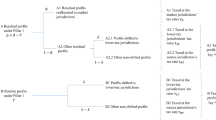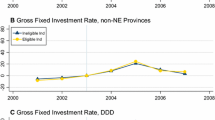Abstract
Corporate tax reforms carried out in EU countries since 1980 entail lower statutory tax rates and reductions in generous tax depreciation provisions. Several countries including the UK have reduced tax rates for small and medium sized enterprises (SMEs). This study compares incentive effects of such reforms on the SMEs’ investment decisions adopting a simple present value model. Ceteris paribus, tax rates and depreciation rules vary in the model simulation, while the application of historical cost accounting method in inflationary phases leads to fictitious increases in nominal net present value. Apart from the construction of international ranking, country-specific patterns of reform effects are also illustrated.
Similar content being viewed by others
References
Altshuler R. and Grubert H. (2003). Repatriation Taxes, Repatriation Strategies and Multinational Financial Policy. Journal of Public Economics 87: 73–107
Alvarez L., Kanniainen V. and Södersten J. (2000). Why Is the Corporation Tax Not Neutral?. Finanzarchiv 56: 285–309
Alworth J. (1988). The Finance, Investment and Taxation Decisions of Multinationals. Basil Blackwell, New York
Atkinson A. B. and Stiglitz J. E. (1980). Lectures on Public Economics. McGraw-Hill, London
Chen D., Lee F. C. and Mintz J. (2002). Taxation, SMEs and Entrepreneuship, STI Working Paper 2002/9. OECD, Paris
Cohen D. and Hassett K. A. (1999). Inflation, Taxes and Durability of Capital. National Tax Journal 52: 91–98
Coyne E. J. (1995). Proposed Analytical Model for FDI Attraction Into Developing Countries, Essays in International Business 1, The International Business Center, College of Professional Studies. University of the District of Columbia, Washington, D.C
Desai M., Foley F. and Hines J. R. (2004). Foreign Direct Investment in a World of Multiple Taxes. Journal of Public Economics 88: 2727–2744
Devereux P. M. (2004). Measuring Taxes on Income from Capital. In: Sørensen, P. B. (eds) Measuring the Tax Burden on Capital and Labor, pp 35–71. MIT Press, Cambridge
Devereux P. M. and Griffith R. (1998). Taxes and the Location of Production: Evidence from a Panel of US Multinationals. Journal of Public Economics 68: 335–367
Devereux P. M. and Griffith R. (2002). The Impact of Corporate Taxation on the Location of Capital: A Review. Swedish Economic Policy Review 9: 79–102
Devereux P. M. and Griffith R. (2003). Evaluating Tax Policy for Location Decisions. International Tax and Public Finance 10: 107–126
Devereux P. M., Griffith R. and Klemm A. (2002). Corporate Income Tax Reforms and International Tax Competition. Economic Policy 35: 451–495
Devereux P. M., Griffith R. and Klemm A. (2004). Why Has the UK Corporation Tax Raised So Much Revenue?. Fiscal Studies 25: 367–388
European Commission, 2001, Company Taxation in the Internal Market, Commission Staff Working Paper SEC(2001) 1681
Evans M. K. (1983). The Truth About Supply-Side Economics. Basic Books, New York
Feldstein M. S. (1979). Adjusting Depreciation in an Inflationary Economy: Indexing versus Acceleration. NBER Working Paper Series 395, Cambridge, Mass
Feldstein M. S. and Summers L. (1979). Inflation and the Taxation of Capital Income in the Corporate Sector. National Tax Journal 32: 445–471
Gordon R., Kalambokidis L. and Slemrod J. (2004). A New Summary Measure of the Effective Tax Rate on Investment. In: Sørensen, P. B. (eds) Measuring the Tax Burden on Capital and Labor, pp 99–128. MIT Press, Cambridge
Griffith R. and Klemm A. (2004). What Has Been the Tax Competition Experience of the Last 20 Years?, IFS WP04/05. The Institute for Fiscal Studies, London
Grubert H. (1998). Taxes and the Division of Foreign Operating Income among Royalties, Interest, Dividends and Retained Earnings. Journal of Public Economics 68: 269–290
Grubert H. (2003). Intangible Income, Intercompany Transactions, Income Shifting and the Choice of Location. National Tax Journal, Part 2, 56: 221–242
Grubert H. (2004). The Tax Burden on Cross-border Investment: Company Strategies and Country Responses. In: Sørensen, P. B. (eds) Measuring the Tax Burden on Capital and Labor, pp 130–170. MIT Press, Cambridge
Hall R. E. and Jorgenson D. (1967). Tax Policy and Investment Behavior. American Economic Review 57: 391–414
Haufler A. and Schjelderup G. (2000). Corporate Tax System and Cross Country Profit Shifting. Oxford Economic Papers 52: 306–325
Hendricks K., Amit R. and Whistler D. (1997). Business Taxation of Small and Medium-sized Enterprises in Canada. Department of Finance Working Paper 97–11, Government of Canada, Ottawa
Hines J. R. (1999). Lessons from Behavioural Responses to International Taxation. National Tax Journal 52: 305–322
Hulten C. R. and Wykoff F. C. (1996). Issues in the Measurement of Economic Depreciation: Introductory Remarks. Economic Inquiry 34: 10–23
Janeba E. (1995). Corporate Income Tax Competition, Double Taxation and Foreign Direct Investment. Journal of Public Economics 56: 311–325
Kay J. A. (1977). Inflation Accounting: A Review Article. Economic Journal 87: 300–311
Keen M. J. (1991). Corporation Tax, Foreign Direct Investment and the Single Market. In: Winters, L. A. and Venables, A. J. (eds) The Impact of 1992 on European Trade and Industry, pp. Cambridge University Press, Cambridge
King M. A. and Fullerton D. (1984). The Taxation of Income from Capital: A Comparative Study of the United States, the United Kingdom, Sweden and West Germany. University of Chicago Press, Chicago
Mendoza E. G., Razin A. and Tesar L. L. (1994). Effective Tax Rates in Macroeconomics: Cross-country Estimates on Factor Incomes and Consumption. Journal of Monetary Economics 34: 297–323
Nam C. W. and Radulescu D. M. (2004). Do Corporate Tax Concessions Really Matter for the Success of Free Economic Zones. Economics of Planning 37: 99–123
Nam C. W. and Radulescu D. M. (2005). The Role of Tax Depreciation for Investment Decisions: A Comparison of European Transition Countries. Eastern European Economics 43(5): 5–25
(1991). Taxing Profits in a Global Economy: Domestic and International Issues. Organisation for Economic Co-operation and Development, Paris
(1998). Harmful Tax Competition: An Emerging Global Issue. Organisation for Economic Co-operation and Development, Paris
(2000). Towards Global Tax Co-operation: Progress in Identifying and Eliminating Harmful Tax Practices. Organisation for Economic Co-operation and Development, Paris
Ott M., 1984, Depreciation, Inflation and Investment Incentives: The Effects of the Tax Acts 1981 and 1982, Monthly Review of Federal Reserve Bank of St. Louis, November 1984: 17–30
Samuelson P. A. (1964). Tax Deductibility of Economic Depreciation to Ensure Invariant Valuation. Journal of Political Economy 72: 604–606
Santarelli E. and Vivarelli M. (2002). Is Subsidizing Entry an Optimal Policy?. Industrial and Corporate Change 11: 39–52
Sinn H. W. (1987). Capital Income Taxation and Resource Allocation. North-Holland, Amsterdam
Sørensen P. B. ( 2004). Measuring Taxes on Capital and Labor: An Overview of Methods and Issues. In: Sørensen, P. B. (eds) Measuring the Tax Burden on Capital and Labor, pp 1–33. MIT Press, Cambridge
Wilson J. (1999). Theories of Tax Competition. National Tax Journal 52: 269–304
Author information
Authors and Affiliations
Corresponding author
Rights and permissions
About this article
Cite this article
Nam, C.W., Radulescu, D.M. Effects of Corporate Tax Reforms on SMEs’ Investment Decisions under the Particular Consideration of Inflation. Small Bus Econ 29, 101–118 (2007). https://doi.org/10.1007/s11187-006-0003-1
Accepted:
Published:
Issue Date:
DOI: https://doi.org/10.1007/s11187-006-0003-1




